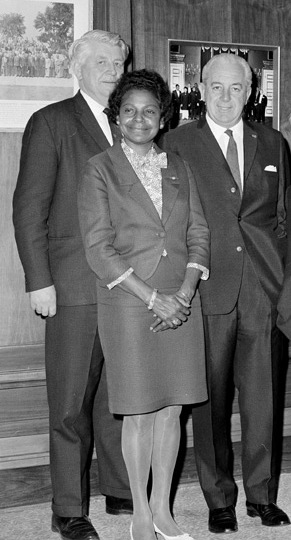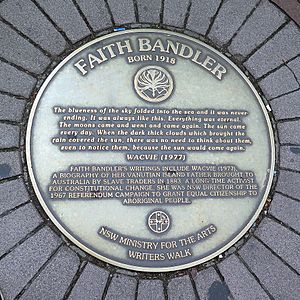Faith Bandler facts for kids
Quick facts for kids
Faith Bandler
AC MBE
|
|
|---|---|

Bandler meeting with Gordon Bryant (left) and Prime Minister Harold Holt in the lead-up to the 1967 referendum
|
|
| Born | 27 September 1918 |
| Died | 13 February 2015 (aged 96) |
| Spouse(s) | Hans Bandler |
| Children | Lilon Gretl Bandler, Peter Bandler |
| Awards |
|
Faith Bandler (born Ida Lessing Faith Mussing) was an amazing Australian who fought for fairness and equal rights. She was born on September 27, 1918, and passed away on February 13, 2015. Her family came from the South Sea Islands and also had Scottish and Indian roots.
Faith is most famous for leading the big campaign for the 1967 referendum. This was a special vote that helped change laws for Indigenous Australians. She also worked hard for the rights of South Sea Islanders.
Contents
Faith Bandler's Early Life
Faith Bandler was born in Tumbulgum, New South Wales. She grew up on a farm near Murwillumbah.
Her Father's Story
Faith's father, Wacvie Mussingkon, was taken from his home on Ambrym Island in what is now Vanuatu. This happened in 1883 when he was only about 13 years old. This practice was called "blackbirding." It involved tricking or forcing people to work as cheap labour. Many were brought to Australia to work on sugar cane farms.
Wacvie was sent to Mackay, Queensland, to work on a sugar cane plantation. He later managed to escape. He then married Faith's mother, who was a Scottish-Indian woman from New South Wales. Faith's father became known as Peter Mussing. He was a lay preacher and worked on a banana farm.
Faith's father died when she was only five years old. His difficult experiences as a forced labourer deeply inspired Faith. These stories made her want to fight for justice and equality.
In 1934, Faith finished school. She moved to Sydney and started working as a dressmaker's apprentice.
Faith Bandler's Career and Activism
Faith Bandler dedicated her life to fighting for human rights. She worked tirelessly to make Australia a fairer place for everyone.
Working During World War II
During World War II, Faith and her sister Kath joined the Australian Women's Land Army. They worked on fruit farms. Faith noticed that Indigenous workers and she were paid less than white workers. This unfairness made her even more determined to fight for equal pay. After the war ended in 1945, she began her campaign for fair wages for Indigenous workers.
Becoming a Community Leader
In 1956, Faith became a full-time activist. She helped start an important group in Sydney called the Aboriginal-Australian Fellowship. She worked with other strong leaders like Pearl Gibbs, Bert Groves, and Grace Bardsley.
Faith also joined the Federal Council for the Advancement of Aborigines and Torres Strait Islanders (FCAA). This group was formed in 1957. As the general secretary of FCAA, Faith led a huge campaign. She wanted to change the Constitution of Australia to remove unfair rules against Indigenous Australians.
The 1967 Referendum Campaign
Faith helped organize many petitions and hundreds of public meetings. Her hard work led to the 1967 referendum. This was a national vote where Australians decided on changes to the Constitution.
The referendum was a huge success! Nearly 91 percent of Australians voted "yes." This vote gave the Australian Federal Government the power to make laws for Indigenous Australians. It also meant Indigenous Australians would be counted in the national census. This was a massive step forward for equality.
In 1975, Faith visited Ambrym Island. This was the island where her father had been taken from 92 years earlier. Throughout the 1970s, Faith was also an important member of the Women's Electoral Lobby in New South Wales. This group worked to improve women's rights.
Writing Books
From 1974, Faith started writing several books. Two of her books were about the 1967 referendum. She also wrote about her brother's life and a novel about her father's experience with blackbirding.
Faith also began campaigning for the rights of South Sea Islander Australians. This was a challenging fight. Some historians wrongly claimed that the blackbirded South Sea Islanders came to Australia willingly. Faith had to correct these misunderstandings. She also faced challenges from some Indigenous Australians who were moving towards a "Black Power" idea, which sometimes made it harder for her to unite different groups.
Faith Bandler's Personal Life
In 1952, Faith married Hans Bandler. Hans was a Jewish refugee from Vienna, Austria. During World War II, Hans had been held in forced labour camps.
Faith and Hans had a daughter named Lilon Gretl, born in 1954. They also fostered an Aboriginal Australian son named Peter. Sadly, they lost touch with Peter when he later left to find his own family.
Hans passed away in 2009. Faith Bandler died in February 2015, at the age of 96.
Awards and Recognition
Faith Bandler received many honours for her amazing work:
- She was offered a Member of the Order of the British Empire (MBE) in 1976, but she chose not to accept it.
- On June 11, 1984, she was made a Member of the Order of Australia (AM). This was to recognize her service to Aboriginal welfare.
- In 1994, she received an honorary doctorate from Macquarie University.
- She was awarded the 1997 Human Rights Medal.
- Faith was named one of the 100 first Australian Living Treasures by the National Trust of Australia.
- On Australia Day, January 26, 2009, she was given the highest honour: a Companion of the Order of Australia (AC).
- In 2001, she was included on the Victorian Honour Roll of Women.
A portrait of Faith Bandler, painted by Margaret Woodward in 1993, is kept at the State Library of New South Wales. After her death, the Prime Minister, Tony Abbott, offered her family a special state funeral.
Selected Works
Faith Bandler wrote several important books:
- Wacvie (1977)
- Marani in Australia (with Len Fox, 1980)
- The Time was Ripe: A History of the Aboriginal-Australian Fellowship (with Len Fox, 1983)
- Welou, My Brother (1984)
- Turning the Tide: A Personal History of the Federal Council for the Advancement of Aborigines and Torres Strait Islanders (1989)


